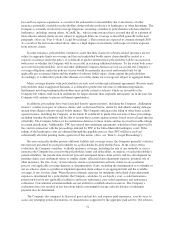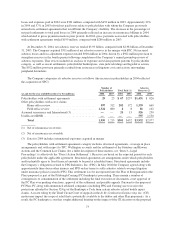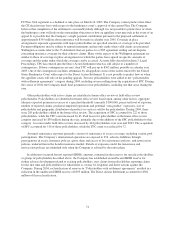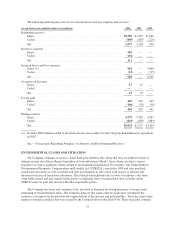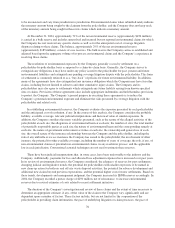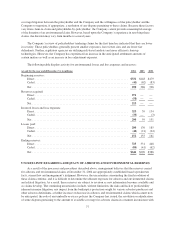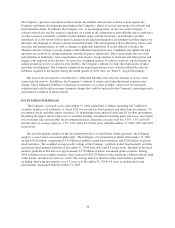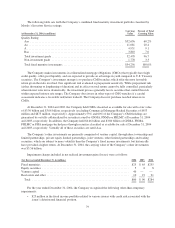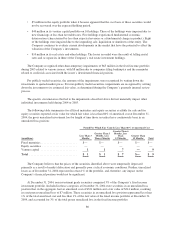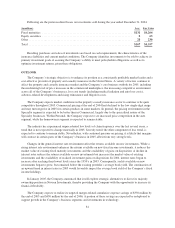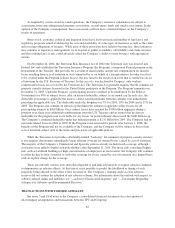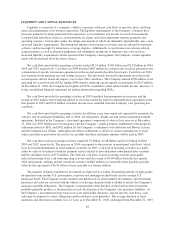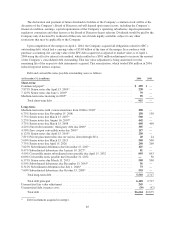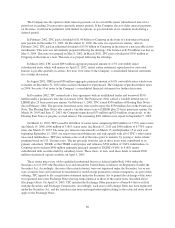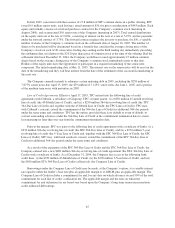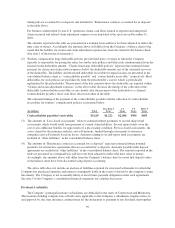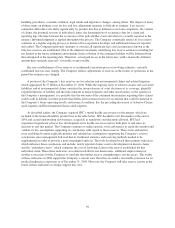Travelers 2004 Annual Report Download - page 94
Download and view the complete annual report
Please find page 94 of the 2004 Travelers annual report below. You can navigate through the pages in the report by either clicking on the pages listed below, or by using the keyword search tool below to find specific information within the annual report.As required by various state laws and regulations, the Company’s insurance subsidiaries are subject to
assessments from state-administered guaranty associations, second-injury funds and similar associations. In the
opinion of the Company’s management, these assessments will not have a material impact on the Company’s
results of operations.
Some social, economic, political and litigation issues have led to an increased number of legislative and
regulatory proposals aimed at addressing the cost and availability of some types of insurance as well as the claim
and coverage obligations of insurers. While most of these provisions have failed to become law, these initiatives
may continue as legislators and regulators try to respond to public availability, affordability and claim concerns
and the resulting laws, if any, could adversely affect the Company’s ability to write business with appropriate
returns.
On November 26, 2002, the Terrorism Risk Insurance Act of 2002 (the Terrorism Act) was enacted into
Federal law and established the Terrorism Insurance Program (the Program), a temporary Federal program in the
Department of the Treasury, that provides for a system of shared public and private compensation for insured
losses resulting from acts of terrorism or war committed by or on behalf of a foreign interest. In order for a loss
to be covered under the Program (subject losses), the loss must be the result of an event that is certified as an act
of terrorism by the U.S. Secretary of Treasury. In the case of a war declared by Congress, only workers’
compensation losses are covered by the Terrorism Act. The Terrorism Act generally requires that all commercial
property casualty insurers licensed in the United States participate in the Program. The Program terminates on
December 31, 2005. Under the Program, a participating insurer is entitled to be reimbursed by the Federal
Government for 90% of subject losses, after an insurer deductible, subject to an annual cap. In each case, the
deductible percentage is applied to the insurer’s direct earned premiums from the calendar year immediately
preceding the applicable year. The deductible under the Program was 7% for 2003, 10% for 2004 and is 15% for
2005. The Program also contains an annual cap that limits the amount of aggregate subject losses for all
participating insurers to $100 billion. Once subject losses have reached the $100 billion aggregate during a
program year, there is no additional reimbursement from the U.S. Treasury and an insurer that has met its
deductible for the program year is not liable for any losses (or portion thereof) that exceed the $100 billion cap.
The Company’s estimated deductible under this federal program is $2.51 billion for 2005. The Company had no
terrorism-related losses in 2004 or 2003. If the Program is not renewed for periods after January 1, 2006, the
benefits of the Program will not be available to the Company, and the Company will be subject to losses from
acts of terrorism subject only to the terms and provisions of applicable policies.
While the Terrorism Act provides a Federally-funded “backstop” for commercial property casualty insurers,
it also requires that insurers immediately begin offering coverage for insured losses caused by acts of terrorism.
The majority of the Company’s Commercial and Specialty policies already included such coverage, although
exclusions were added to higher-risk policyholders after September 11, 2001. For those risks considered higher-
risk, such as landmark buildings or high concentrations of employees in one location, the Company will continue
to either decline to offer a renewal or will offer coverage for losses caused by acts of terrorism on a limited basis,
with an explicit charge for the coverage.
There are currently various state and federal legislative and judicial proposals to require asbestos claimants
to demonstrate an asbestos illness. At this time it is not possible to predict the likelihood or timing of such
proposals being enacted or the effect if they are enacted. The Company’s ongoing analysis of its asbestos
reserves did not assume the adoption of any asbestos reforms. For information about the outlook with respect to
asbestos-related claims and liabilities see “—Asbestos Claims and Litigation” and “—Uncertainty Regarding
Adequacy of Asbestos and Environmental Reserves.”
TRANSACTIONS WITH FORMER AFFILIATE
See notes 3 and 18 of notes to the Company’s consolidated financial statements for a description of
intercompany arrangements and transactions between TPC and Citigroup.
82


